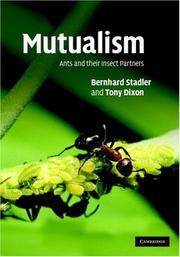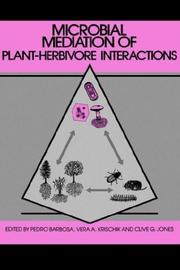| Listing 1 - 10 of 17 | << page >> |
Sort by
|
Book
ISBN: 0198540272 Year: 1993 Publisher: Oxford : Oxford university press,
Abstract | Keywords | Export | Availability | Bookmark
 Loading...
Loading...Choose an application
- Reference Manager
- EndNote
- RefWorks (Direct export to RefWorks)
Mutualism (Biology) --- Biotic communities --- Food chains (Ecology) --- Congresses. --- Congresses. --- Congresses.
Book
ISBN: 9780199675654 9780199675661 Year: 2015 Publisher: Oxford : Oxford University Press,
Abstract | Keywords | Export | Availability | Bookmark
 Loading...
Loading...Choose an application
- Reference Manager
- EndNote
- RefWorks (Direct export to RefWorks)
Mutualism (Biology) --- Evolution (Biology) --- Mutualisme (biologie) --- Évolution (biologie)
Book
ISBN: 9781784052560 Year: 2017 Publisher: London : ISTE Editions,
Abstract | Keywords | Export | Availability | Bookmark
 Loading...
Loading...Choose an application
- Reference Manager
- EndNote
- RefWorks (Direct export to RefWorks)
Mutualism (Biology) --- Symbiosis --- Microorganisms. --- Mutualisme (biologie) --- Symbiose. --- Microorganismes.

ISBN: 9780521860352 0521860350 9780511542176 9780511395017 0511395019 0511542178 9780511392344 1107177782 1281370746 9786611370749 0511394365 0511392346 0511391056 0511393652 Year: 2008 Publisher: Cambridge Cambridge University Press
Abstract | Keywords | Export | Availability | Bookmark
 Loading...
Loading...Choose an application
- Reference Manager
- EndNote
- RefWorks (Direct export to RefWorks)
A mutualism is an interaction between individuals of two different species of organism in which both benefit from the association. With a focus on mutualisms between ants and aphids, coccids, membracids and lycaenids, this volume provides a detailed account of the many different facets of mutualisms. Mutualistic interactions not only affect the two partners, but can also have consequences for higher levels of organization. By linking theory to case studies, the authors present an integrated account of processes and patterns of mutualistic interactions at different levels of organisation, from individuals to communities to ecosystems. Interactions between ants and their insect partners and their outcomes are explained from a resource-based, cost-benefit perspective. Covering a fascinating and growing subject in modern ecology, this book will be of interest to community and evolutionary ecologists and entomologists, at both research and graduate student level.
Evolution. Phylogeny --- General ecology and biosociology --- Insects. Springtails --- Mutualism (Biology) --- Ants --- Ecology --- Symbiosis --- Ecology.
Book
ISBN: 1009258354 1139020293 Year: 2022 Publisher: Cambridge : Cambridge University Press,
Abstract | Keywords | Export | Availability | Bookmark
 Loading...
Loading...Choose an application
- Reference Manager
- EndNote
- RefWorks (Direct export to RefWorks)
Mycorrhizae are mutualisms between plants and fungi that evolved over 400 million years ago. This symbiotic relationship commenced with land invasion, and as new groups evolved, new organisms developed with varying adaptations to changing conditions. Based on the author's 50 years of knowledge and research, this book characterizes mycorrhizae through the most rapid global environmental changes in human history. It applies that knowledge in many different scenarios, from restoring strip mines in Wyoming and shifting agriculture in the Yucatán, to integrating mutualisms into science policy in California and Washington, D.C. Toggling between ecological theory and natural history of a widespread and long-lived symbiotic relationship, this interdisciplinary volume scales from structure-function and biochemistry to ecosystem dynamics and global change. This remarkable study is of interest to a wide range of students, researchers, and land-use managers.
Mycorrhizal fungi --- Mutualism (Biology) --- Plant-fungus relationships. --- Plant-soil relationships. --- Ecology.
Book
ISBN: 9782711752836 2711752836 Year: 2001 Publisher: Paris : Vuibert,
Abstract | Keywords | Export | Availability | Bookmark
 Loading...
Loading...Choose an application
- Reference Manager
- EndNote
- RefWorks (Direct export to RefWorks)
Symbiosis --- Mutualism (Biology) --- Evolution (Biology) --- Ecology --- Symbiose. --- Mutualisme (biologie) --- Évolution (biologie) --- Écologie. --- Évolution (biologie) --- Écologie.

ISBN: 047161324X Year: 1991 Publisher: New York (N.Y.) : Wiley,
Abstract | Keywords | Export | Availability | Bookmark
 Loading...
Loading...Choose an application
- Reference Manager
- EndNote
- RefWorks (Direct export to RefWorks)
Multi
ISBN: 9780521831499 9780521539104 Year: 2022 Publisher: Cambridge Cambridge University Press
Abstract | Keywords | Export | Availability | Bookmark
 Loading...
Loading...Choose an application
- Reference Manager
- EndNote
- RefWorks (Direct export to RefWorks)
"The Perigord Truffle, Tuber melanosporum Vittad 1831, as of this writing, could be purchased for $19.97 per 14g (0.5oz), or US$1,426 per kg. These "black diamonds" are one of the ultimate human gastronomic experiences. Yet, despite centuries of study by outstanding scientists, the biology of truffles is so poorly understood that they cannot be commercially produced in consistent, meaningful quantities. Most gastronomic truffles still come from individual truffle hunters, working in orchards or wildlands and selling to expert middlemen, then to the international market often through back doors (see (375)). Efforts to collect truffles have been undertaken throughout recorded history as Romans, Greeks, Babylonians, Sumerians, and Egyptians all wrote about the fruit of Aphrodite (Aristotle). The complexity of formation, attributed to particular trees, lightning or thunder, or soils led to extensive research during the 19th century, culminating in the funding of the work of Albert Bernhard Frank, a forest pathologist, supported by the King of Prussia. Little did any of the early researchers recognize that the biology of Tuber was only a small, yet complicated piece of a story of a diverse type of symbiosis, that plays a major storyline in biological theory, in the application of agriculture and forestry, and holds keys to how carbon was sequestered in the early earth and provides directions to reducing the global CO2-climate impacts. Truffles, including members of the genus Tuber, are mycorrhizal fungi. That is, they are mutualistic fungi, associated with a limited array of host trees, such as oaks, beeches, and hazelnuts. Being a mutualistic symbiont means that not only is the ecology of the fungus complex, but the ecology of the host is also complex. Adding in the complexity of climate and soils that change over time and space, the association falls into the theoretical construct of biology called biocomplexity"--
Eumycetes --- fungi --- ecologie --- Mycorrhizal fungi --- Mutualism (Biology) --- Plant-fungus relationships. --- Plant-soil relationships. --- Mycorhizes --- Mutualisme (biologie) --- Relations plante-champignon. --- Relations plante-sol. --- Ecology. --- Écologie. --- Écologie.
Book
ISBN: 9780521539104 9780521831499 9781139020299 0521831490 0521539102 Year: 2022 Publisher: Cambridge Cambridge University Press
Abstract | Keywords | Export | Availability | Bookmark
 Loading...
Loading...Choose an application
- Reference Manager
- EndNote
- RefWorks (Direct export to RefWorks)
"The Perigord Truffle, Tuber melanosporum Vittad 1831, as of this writing, could be purchased for $19.97 per 14g (0.5oz), or US$1,426 per kg. These "black diamonds" are one of the ultimate human gastronomic experiences. Yet, despite centuries of study by outstanding scientists, the biology of truffles is so poorly understood that they cannot be commercially produced in consistent, meaningful quantities. Most gastronomic truffles still come from individual truffle hunters, working in orchards or wildlands and selling to expert middlemen, then to the international market often through back doors (see (375)). Efforts to collect truffles have been undertaken throughout recorded history as Romans, Greeks, Babylonians, Sumerians, and Egyptians all wrote about the fruit of Aphrodite (Aristotle). The complexity of formation, attributed to particular trees, lightning or thunder, or soils led to extensive research during the 19th century, culminating in the funding of the work of Albert Bernhard Frank, a forest pathologist, supported by the King of Prussia. Little did any of the early researchers recognize that the biology of Tuber was only a small, yet complicated piece of a story of a diverse type of symbiosis, that plays a major storyline in biological theory, in the application of agriculture and forestry, and holds keys to how carbon was sequestered in the early earth and provides directions to reducing the global CO2-climate impacts. Truffles, including members of the genus Tuber, are mycorrhizal fungi. That is, they are mutualistic fungi, associated with a limited array of host trees, such as oaks, beeches, and hazelnuts. Being a mutualistic symbiont means that not only is the ecology of the fungus complex, but the ecology of the host is also complex. Adding in the complexity of climate and soils that change over time and space, the association falls into the theoretical construct of biology called biocomplexity."--
Mycorrhizal fungi - Ecology --- Mutualism (Biology) --- Plant-fungus relationships --- Plant-soil relationships --- Mycorrhizal fungi --- Plant-fungus relationships. --- Plant-soil relationships. --- Mycorhizes --- Mutualisme (biologie) --- Relations plante-champignon. --- Relations plante-sol. --- Ecology. --- Écologie.
Book
ISBN: 9783319139210 3319139207 9783319139203 3319139215 Year: 2015 Publisher: Cham : Springer International Publishing : Imprint: Springer,
Abstract | Keywords | Export | Availability | Bookmark
 Loading...
Loading...Choose an application
- Reference Manager
- EndNote
- RefWorks (Direct export to RefWorks)
This monograph provides an overview of beneficial plant-bacterial interactions in a straightforward and easy-to-understand format, and includes a wealth of unique illustrations elaborating every major point. Study questions that emphasize the key points are provided at the end of each chapter. One way to feed all of the people in the world’s growing population is through the increased use of plant-growth-promoting bacteria in agriculture. These bacteria not only directly promote growth but also protect plants against a wide range of biotic and abiotic stresses. Moreover, they can be used to support procedures for biologically cleaning up the environment. Plant-growth-promoting bacteria are already being used successfully on a small scale in several countries, and as this technology matures, the world may witness a major paradigm shift in agricultural practice.
Life Sciences. --- Microbiology. --- Plant Physiology. --- Agriculture. --- Life sciences. --- Plant physiology. --- Sciences de la vie --- Agriculture --- Microbiologie --- Physiologie végétale --- Host-bacteria relationships. --- Mutualism (Biology). --- Plant molecular biology. --- Biology --- Health & Biological Sciences --- Microbiology & Immunology --- Mutualism (Biology) --- Bacteria-host relationships --- Relationships, Host-bacteria --- Molecular phytobiology --- Phytobiology, Molecular --- Symbiosis --- Host-parasite relationships --- Botany --- Molecular biology --- Farming --- Husbandry --- Industrial arts --- Life sciences --- Food supply --- Land use, Rural --- Plants --- Physiology --- Microbial biology --- Microorganisms
| Listing 1 - 10 of 17 | << page >> |
Sort by
|

 Search
Search Feedback
Feedback About UniCat
About UniCat  Help
Help News
News